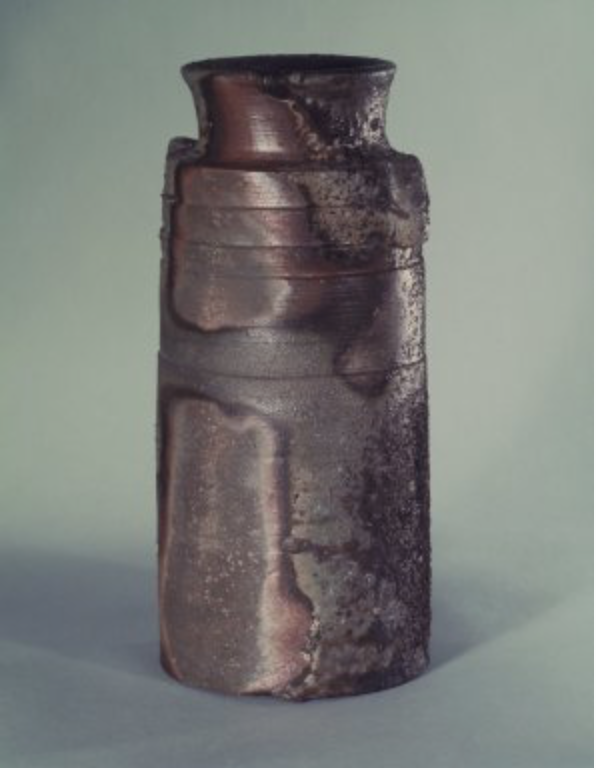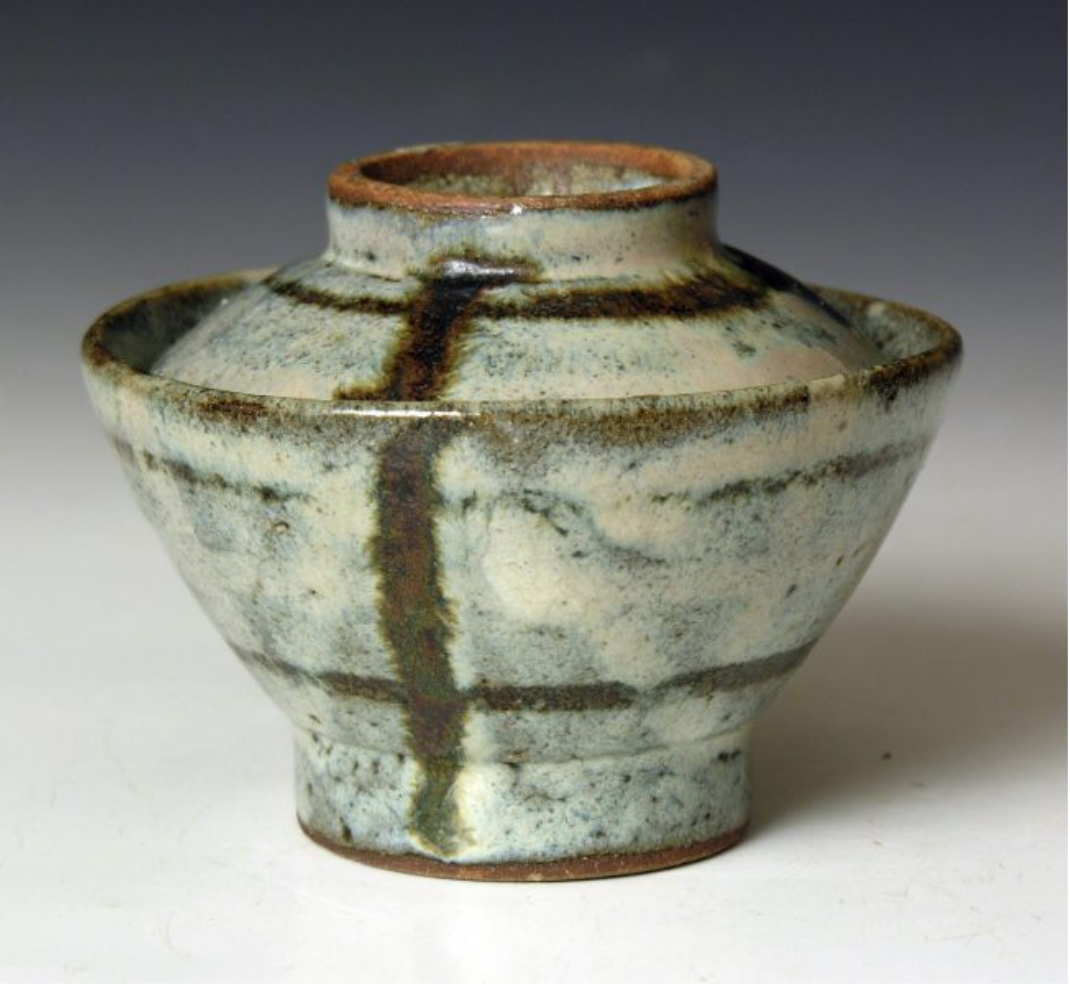The ceramic arts—stoneware and porcelain—are the most vigorous of Japanese crafts. It has the greatest number of artisans—probably more per capita than in any other country—and a steady, discerning clientele among the average Japanese. This is due both to the tea ceremony, with its connoisseur's appreciation of folk-style pottery, and the artistry demanded by Japanese cuisine.
Stoneware is made from high-grade clay which is fired at 600 to 900°C, making it hard and nonporous. The variety and history of Japanese kilns almost defy description. Perhaps a hundred pottery villages still exist. Among the so-called Six Ancient Kilns, pottery communities dating to the thirteenth century, BIZEN and Shigaraki still produce rough-textured wares encrusted with molten ash, originally simple peasant wares that were praised and collected by sixteenth-century tea masters. TAMBA produces attractive, inexpensive dishes, crocks and bonsai pots, glazed in rich black-browns, ambers and bluish whites little changed since the Momoyama period (16th century). The biggest pottery town, Seto, is a highly automated commercial center (famous abroad for Noritake china). It also has individual artisans working in such venerable traditions as temmoku, the Sung Chinese "oil drop" or "hare's fur" glazes, and Ki-Seto, a yellow-green imitation celadon, both originating in the Kamakura period (12th to 14th centuries); Oribe, a yellowish ware with brushed designs in iron underglaze covered by translucent splashes of blue-green, supposedly invented by the Momoyama-period tea master Furuta Oribe (see Villas and Gardens: The Tea Ceremony); and Shino, also prized by tea connoisseurs.
Bizen-yaki flower vase (By Brooklyn Museum. CC BY 3.0)
In Kyūshū and western Honshū, there are numerous kilns that show strong Korean influences; many were founded in the Momoyama period as a legacy of HIDEYOSHI's ill-fated Korean campaigns. Among Hideyoshi's generals were tea enthusiasts who, although they failed to conquer Korea, managed to capture hundreds of potters and bring them back to Japan, where they were made to produce the prized Korean-style bowls. This is why the Korean campaigns are often called "the pottery wars." HAGI, a lovely castle town in western Honshū, is famous for Hagi-yaki, a pinkish-beige ware that resembles the Ido rice bowls that first ignited the interest of Japan's tea masters. KARATSU, an ancient port on the northern Kyūshū coast, is typified by E-Garatsu ("illustrated Karatsu"), similar to Korean Yi dynasty wares, with handsome, floral or geometric motifs freely brushed in deep-brown iron oxides and covered with translucent or whitish glazes. Other types of Karatsu ware employ Korean techniques such as hakeme, broad swatches of white slip applied with a wide brush over underrated clay, and mishima, in which the clay surface is punched with small holes and filled with white slip.
Hagi-yaki tea bowl
Satsuma-yaki, made by Korean descendants in KAGOSHIMA, includes both the refined mock-porcelain called Shiro (White) Satsuma, a stoneware with colorful overglaze enamel decoration over a finely crazed ivory skin, and Kuro (Black) Satsuma, a folk pottery made for the potters' own use. ONTA and KOISHIWARA, two mountain villages in northeastern Kyūshū, produce genuine folk pottery derived from Korean wares, with decorative techniques such as tobi-kanna, a "flying blade" that is chattered across the leather-hard surface as the piece is turned on the wheel, creating a fine, spoke-like pattern. These are among the most attractive and distinctive folk potteries made today.
Onta-yaki plate. By fitm. CC BY-SA 3.0
Kyūshū was also the birthplace of Japanese porcelain. Production was established in the early seventeenth century after Ri Sanpei, a Korean potter, discovered kaolin near present-day ARITA. Porcelain is a medium quite unlike stoneware; made from the purest white clay (kaolin) and fired at much higher temperatures (1300–l400°C). It vitrifies into an impermeable, translucent material that rings like a bell when struck. The technical demands are much greater and, whereas stoneware can be prized for an earthy naturalness and "kiln accidents" (cracks, streaks and grains that form during firing), porcelain never is. It is judged by the technical perfection of its form and glaze. At a kiln such as Imaizumi Imaemon, heir to the exalted Iro-Nabeshima tradition, ninety percent of the output was judged below standard and destroyed. Iro-Nabeshima, considered one of the finest porcelains ever made, was for the exclusive use of the Nabeshima daimyo and until the Meiji period was unknown in the West. This was not the case with the celebrated kiln of Kakiemon, whose founder perfected the use of brilliant overglaze enamels fourteen generations ago.
“Kaikiemon bowl circa 1640 (By World Imaging. CC BY-SA 3.0)”
Although the Nabeshima domain jealously guarded its porcelain industry, the secrets leaked out, and porcelain spread to a few other regions, notably KANAZAWA, KYOTO and Seto. Kutani-yaki, patronized by the Maeda lords of Kanazawa, is distinctive, with a bold mix of pictorial and geometric motifs executed in a near-black underglaze and rich overglazes of blues, green, purple and yellow. Kyoto's Kiyomizu-yaki, sold around the approach to Kiyomizu Temple, consists mainly of porcelain, which began to be produced on a large scale in the late Edo period. As one might expect, it is colorful and elegant, drawing upon an eclectic tradition—not only in ceramics, but in textiles, lacquer design and painting—molded to the Kyoto taste.
With such a burden of history, it is fortunate that Japanese potters continue to develop in exciting new ways, nourished rather than smothered by tradition. Leaders in the folk-art revival were Hamada Shōji (1894–1978), Kawai Kanjirō (1890–1966), and Tomimoto Kenkichi (1886–1963) (Tomimoto is often considered not to be a folk potter because he worked in elegant, enameled porcelain and signed his pieces). Hamada's farmhouse studio in the now-famous pottery town of MASHIKO, Kawai's house in Kyoto and Tomimoto's house near Nara's Hōryū-ji are now museums, worth a visit by anyone with an interest in modern Japanese ceramic art.
A Covered Rice Bowl by Hamada Shoji (Phil Rogers gallery)
For more information and terminology about Japanese ceramic arts and listings of the best pottery shops and villages, consult Gateway to Japan, Digital Edition.







